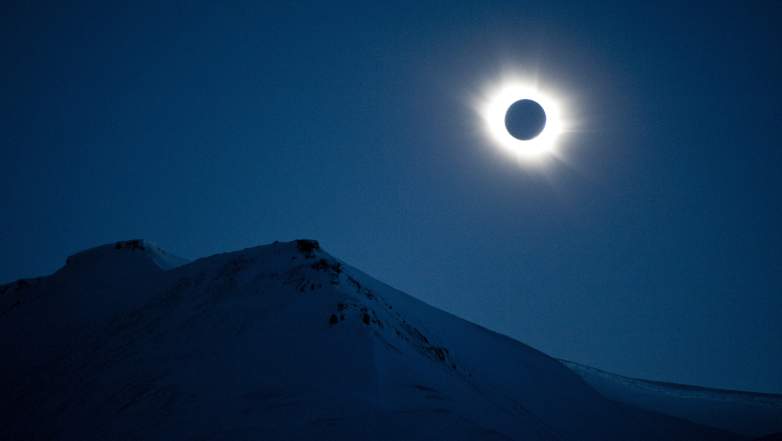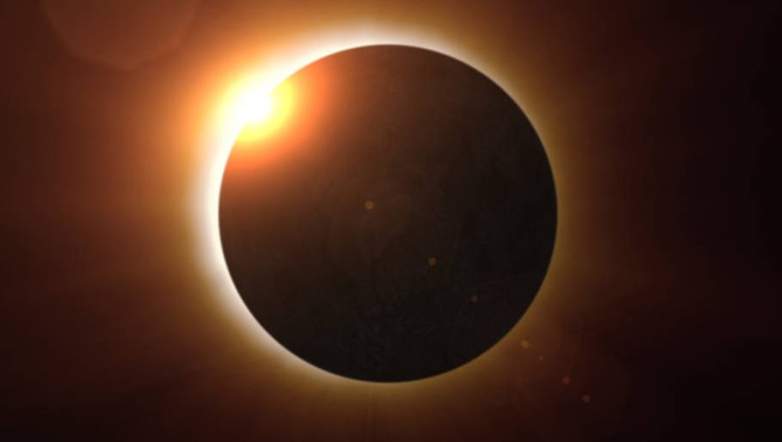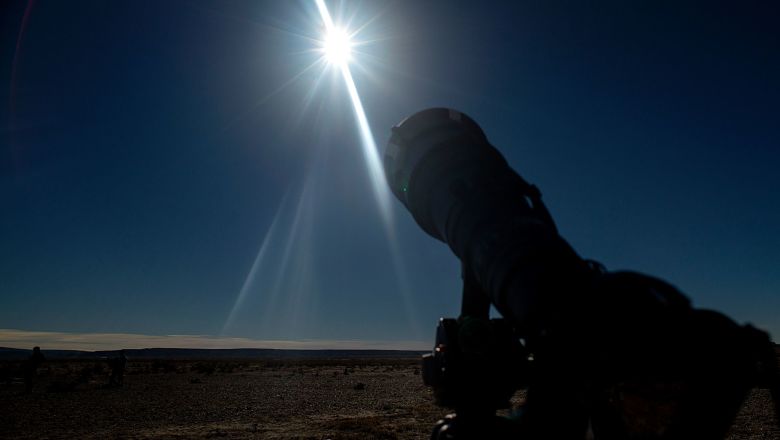
Getty A total solar eclipse is pictured from the city of Ternate, in Indonesia's Maluku Islands, on March 9, 2016.
With the solar eclipse looming on August 21, 2017, many people are wondering how they can get a photo or video of it. After all, it’s not something that happens very often. The last solar eclipse in the contiguous United States was in 1979.
What’s the best way to take photos and videos of a solar eclipse? Are there any tips to get good photographs?
The number one tip for taking images of a solar eclipse is to remember to protect your eyes. Solar eclipse dangers are just as real if you are looking at the sun with a camera (or telescope or binoculars) as they are if you look at the eclipse with a naked eye. Don’t do it without protection. It’s also critically important that you use a solar filter on your camera when taking photos and videos of a solar eclipse.
“When shooting still images or video of a solar eclipse, one rule is paramount: special-purpose solar filters must always remain on cameras and telescopes during the partial phases. Only during totality is it safe to remove them… Filters should fit snugly over the front of all camera lenses and telescopes, but not so tight that they’re difficult to remove quickly at the start of totality,” an American Astronomical Society fact sheet on taking photos and videos during the eclipse reports. You can find these filters for sale at many retailers online.

GettyA total solar eclipse can be seen in Svalbard, Longyearbyen, Norway, on March 20, 2015.
The site says that a typical point-and-shoot camera can work, as long as you’re not interested in close-ups. To get a good closeup, you would need a better camera, “a digital single-lens-reflex (DSLR) or mirrorless interchangeable-lens camera (ILC) with a telephoto lens, or a point-and-shoot camera with a high-power zoom lens.” (If you’re really serious about photography, here’s a shutter speed calculator for the eclipse.)
The American Astronomical Society fact sheet is a good place to start because it contains tips for amateur photographers (use manual focus, stay steady, turn off your flash) and for those striving for more professional shots. Example of the latter: “Here are some tried-and-true combinations of ISO and f-stop that eclipse photographers have been using for many years: ISO 100, f/4; ISO 200, f/5.6; or ISO 400, f/8. With these settings, a crystal-clear sky, and a special-purpose solar filter over your camera lens, you’ll probably find an exposure time between 1,4000 and 1/1,000 second appropriate for use during the partial phases of the solar eclipse.”
According to the American Astronomical Society, the same basic tips apply to camcorders and videography. The site suggests, “During the partial phases, shoot three- to five-second clips of the Sun every four to five minutes to produce a time-lapse sequence that will compress the multi-hour event into minutes.”

NASA
Remember: The dangers of eye damage are very real. NASA has a page devoted to safety precautions.
According to KXAN, “NASA says you will need to purchase a solar filter that will reduce the light intensity. You could use ISO-approved solar eclipse viewing glasses to protect your camera lens from the eclipse. The exception is if you are taking a photo of the brief moment of totality. If you’re using a filter during this time, NASA says you will not be able to see the faint corona in the photograph.”
Not all cameras are created equally, of course. “Almost any kind of camera can be used to capture this rare event; however, a lens with a fairly long focal length is recommended to produce as large an image of the Sun as possible,” suggests MrEclipse.com. The site has a chart that lists field of view dimensions for different focal lengths. It also recommends, “A solar filter must be used on the lens throughout the partial phases for both photography and safe viewing.”

Getty
NASA warns that solar eclipse filters must be properly fitted. Seek out an expert to help you do so. “Do not look at the sun through a camera, a telescope, binoculars, or any other optical device while using your eclipse glasses or hand-held solar viewer — the concentrated solar rays will damage the filter and enter your eye(s), causing serious injury,” warns NASA. “Seek expert advice from an astronomer before using a solar filter with a camera, a telescope, binoculars, or any other optical device. Note that solar filters must be attached to the front of any telescope, binoculars, camera lens, or other optics.”
After making safety precautions, Sky and Telescope advises you to get the proper gear. “The type of camera lens you use will depend on what you want to record. To shoot wide-angle shots of the sky at totality with a digital single-lens reflex (DSLR) camera, a standard 50-millimeter lens is all you need. Although it gives only a minuscule (0.5 mm in diameter) image of the Sun on a full-frame (35-mm-format) DSLR sensor, it is well suited to capturing the totally eclipsed Sun and the surrounding sky,” the site reports.
Sky and Telescope also advises, “If you want the Sun’s disk to be reasonably large in the field of a full-frame DSLR, you will need a telephoto lens or telescope with a focal length between 500 and 2,000 mm on a stable mount. A 1,000-mm lens yields a solar image 9.2 mm across and is perfect for framing the outer corona, which can easily extend more than ½° from the Sun’s limb.” Read additional instructions from Sky and Telescope here.